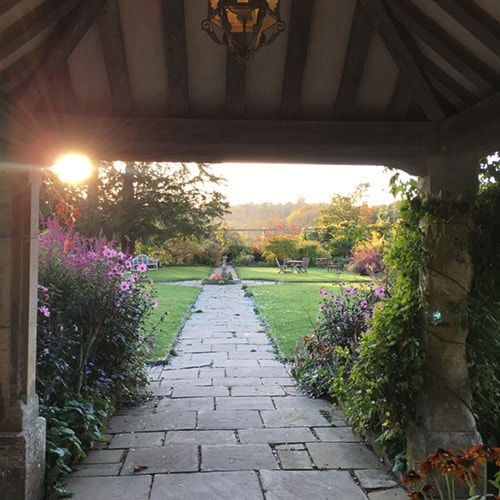When Gravetye’s head gardener Tom Coward met me in a pair of shorts on the last day of October I might have twigged to the semi-tropical splendour in store for me in Sussex. A second before, I’d stepped out of a 16th century manor into a low-angled ray of golden sun. Backlit magenta dahlias glowed from the borders and a hot pink haze of salvia surrounded them. I’d just driven stick with my left-hand for four hours, racing to make it to Gravetye before dark (a trip that was meant to take two hours but somehow involved a pet owl and more adorable ‘hollows’ and wild ‘wealds’ than I meant to see), so I had barely dropped my bags and grabbed my notebook when Tom found me blinking, agog, shamefully stumped at the genus level in 40 seconds flat.
“What salvia…?”
He was all sweat and swagger; bits of bark stuck to his face. With a wide grin and thick palms, he looked every bit the position and passions he held. (Later in the orchard he would reveal himself to be a ‘pomologist,’ soon off to Normandy apple hunting.) His dog Vera wriggled about, and in the moment I knelt to pat her I thought how apt that I bow down.
Until this last trip, I’d forgotten how classically trained gardeners in the UK learn to speak about plants, how they lead talks, learn how to guide eyes around a garden. The week before I’d been up at the Cambo Estate in Scotland and heard Elliot Forsyth give a chat to his two interns: he stood alongside a broad border and taught his students not to only name plants, but to see: shapes, forms, colours. One does not point and prod such a sophisticate with ‘what’s this? what’s that?’ rather one waits as the gardener unfurls their narrative, connecting the plants to the place.
And what a place Gravetye is. William Robinson, one of the most influential of English gardeners, developed the gardens in 1884 until his death in 1934. As a trained plantsman and self-taught writer he argued against the Victorian carpet-bedding of hothouse annuals in favour of a wilder, more naturalistic style (making him a part of the wider Arts & Crafts movement of the time.) His most influential books included The Wild Garden (1870) and The English Flower Garden (1883), which in later editions Gertrude Jekyll contributed to. In fact her success often eclipses Robinson’s, but his legacy – numerous books and a thousand acres strong – is formidable.
And it’s Tom’s job to oversee it.
As a columnist, of course I had to ask names, thus revealing both my ignorance and my bliss. Kid in a candy store? I can’t do better than that cliché, particularly when flowers bright as gum balls stood in my path.
While Tom spoke, I jotted down a list starting with the cerise wonder I’d swooned over walking out of the manor’s heavy oak door: Salvia curviflora with a lipstick-perfect trout pout. In other borders Salvia confertiflora towered above tall Tagetes (French marigolds) and the crimson Dahlia ‘Dove Grove.’ The confertiflora stood over five feet and had long deep maroon pedicels, all studded with minium-coloured ‘flowers’ (yes, you will need to look that colour up, but it has an interesting history).
The house florists had used these blooms in an arrangement I spotted en route to my room and even in my haste I noted how stately it was, spiky yet soft, adding a rich autumnal hue to a simple selection of lilies. (Gravetye is a Relais & Chateaux property with a Michelin star which I’m guessing explains the spendy out-of-season blooms.)
But where were we? Wandering in fall’s fading light, snapping and jotting. Salvia amistad – a stunner with black calyxes and purple blooms. Salvia…
We didn’t have long enough.
I’ll save some of what I learned from Tom for another column and whisk us off to East Sussex where (after supping on pheasant, marigolds, and the gorgeous greens I’d seen in Gravetye’s Victorian walled garden) I headed the following morning.
There, at Sarah Raven’s Perch Hill farm, I attended a floral design class and had the pleasure of a tour led by Sarah. (Her book The Cutting Garden is fantastic.) Again the salvias called and I scribbled: S. ‘Nachtvlinder’ with jaunty flowers; Salvia ‘Tutti Frutti’ a shrubby perennial; the showy raspberry S. involucrata ‘Hadspen’; the muted pink S. greggi ‘Stormy pink’…
Sarah’s salvias were planted throughout her garden for late season splendour – in a patio garden between brick pavers, in pots outside the garden shop, in a small courtyard next to her oast house. Yes, Perch Hill was that lovely, and here’s another reason why: in the hazy mists of autumn, the singe of salvia cheers. Like a red apple on bare tree, there’s something elemental about all that fire burning through fog.
I returned to Gravetye for dinner and after a divine breast of guinea hen, I went hunting in the garden, this time for a second look at the fuzzy Salvia oxyphora, screaming sex alongside towering Aeonium. The next morning I made it to Heathrow in an hour and half. No owls. No hollows. Just a husband happy to see me home.
Christin Geall is an avid Oak Bay gardener and creative non-fiction writing instructor at the University of Victoria
